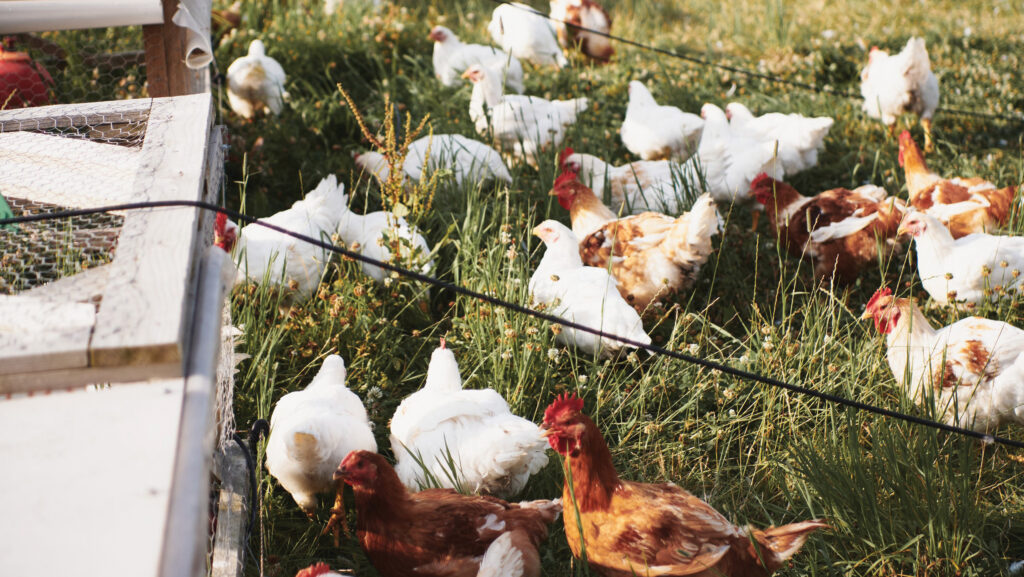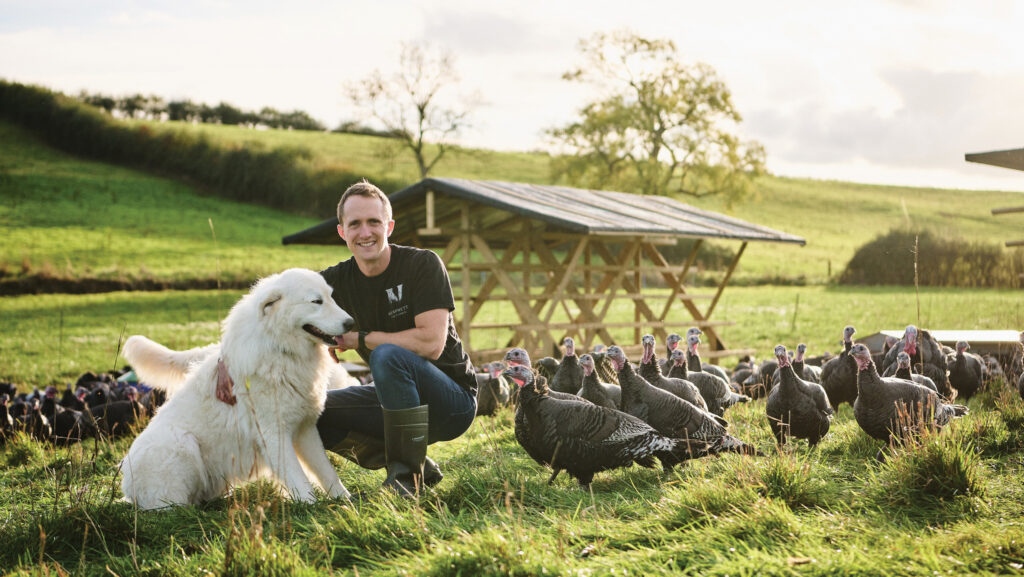Regen poultry: What scope is there to grow production?
 © Nempnett Pastures
© Nempnett Pastures Poultry is often cast as the supervillain in debates around sustainable farming – not least when it comes to whether poultry manure is a benefit or a threat to water quality.
However, there are suggestions that producing poultry on a smaller scale and employing regenerative principles can be good for both the environment and the business model.
See also: Aldi is latest supermarket to give broiler birds more space
James Bentley, technical director of broiler breeding company Hubbard, says there are opportunities for poultry to fit into regenerative systems, particularly where extra value can be generated from marketing their produce.
James points out that in France there is a more developed market for crops with zero tillage, and some farmers have been trying to feed their birds using these crops to meet reduced carbon objectives for their broiler production.
He highlights that slower growing birds may be able to make use of more by-products, as well as soya substitutes, because these birds demand lower nutritional inputs, as a proportion of the total feed use, than standard broilers.
“Slower growing chickens will feature in discussions around nutrient circularity as they use proportionately more of the finisher diet, which is lower [in] protein, meaning there is more opportunity in the diet for other protein sources to feature.”
Pigs to poultry
One business that has managed to put many regenerative principles into practice with its poultry is Nempnett Pastures, run by George Ford.
For many years, the core of the Ford family business, based on the edge of Blagdon Lake in Somerset, was finishing pigs. While they were independent and made a reasonable living, George lacked passion for the system.
Taking on his uncle’s small Christmas turkey business gave him the opportunity to try something different.
Rearing white birds inside spacious straw barns was his starting point, and he was inspired while studying at Harper Adams, by hearing turkey farmer Paul Kelly speak.
“I really wanted to start free ranging them and do a few bronze [birds],” says George. After trying a few with their customers in year two, he found they sold quickly and received excellent feedback.
In the third year of production, he switched entirely to bronze and free-range turkeys.
“We were starting to build a brand called Nempnett Turkeys and I got a lot of enjoyment out of it. I felt really fulfilled by following the whole process, from taking a newly hatched turkey to giving it packaged up to the customer,” he says.
From there, the system evolved to become entirely pasture-based, with birds roosting overnight on perches fitted to an old caravan chassis, dubbed the “Gobbledygo”.
George says he borrowed this idea, among several others, from US regenerative farmer Joel Salatin.
He admits that departing from the tried-and-tested way of rearing turkeys caused some sleepless nights, with worries over the damage a fox could do to the flock.
“It was quite nerve-racking as the turkeys are so high value,” he says.
With a growing customer base, he saw the opportunity to develop his product range using similar principles and branding. He began keeping chickens on pasture, starting with three portable shelters, each measuring 3x4m and containing 100 birds.
The birds are Hubbard JA57s sourced from a nearby free-range farm at about three weeks old, once brooding is finished and they are ready to come off heat.
Three batches are bought each year, with birds reared to between 11 and 14 weeks old.
They are killed with carcass weights ranging from 2kg to a sizeable 4kg. George begins rearing chickens in April and his last batch finishes in October. Some cockerels are kept and grown on until Christmas.
Feeding ambition
While George is not yet able to source regenerative raw materials for his poultry diets, he makes the feed on farm using a mobile mixing wagon and sources wheat and beans from local farms. He also feeds a finisher diet without soya to the turkeys and chickens.
“It would be nice one day if I could get to the point where I could get wheat and beans grown together for the diets, like Wildfarmed do,” he says.
The birds clearly get nutrition from the pasture they live on, he says, with their skin turning a golden yellow as a result of foraging the grasses and broadleaved weeds.
“The chickens will hammer the docks. They love them more than anything, and I’ve also got videos of the turkeys stripping the seeds from the plants,” he says.
Market share
James points out there are challenges with free-range reared poultry, particularly given the pressures from avian influenza in recent times, where mandatory housing orders have been implemented when disease pressure has been at the highest.
This, combined with squeezes on consumer incomes, which have reduced shopper confidence, makes it clear to him that selling any concept is just as important as producing it.
“For a truly regenerative poultry sector following all the principles, they really have to be focused on their marketing to make it all fit together,” he says.
Asked what scope there is for regenerative poultry to start taking a larger market share, James says this may be a challenge, given 20 million broiler chickens are produced in the UK every week.
“Keeping a few hundred chickens for a specialist niche market is one thing, but scaling regenerative approaches to big volumes is quite another.
“For the wider poultry industry, it is about trying to dissect some of the principles of regenerative agriculture and trying to progressively become more circular in the approach, while maintaining efficiency and consumer confidence.”
Use of dogs to protect poultry

George Ford © Nempnett Pastures
Many shepherds will say their job could not be done without a dog, but it is rarer to find a chicken farmer who says the same.
But that is the view of George Ford, who says the outdoor nature of his poultry system means it would be impossible to run without the aid of his three Maremma Italian sheepdogs.
Bred for centuries to help Italian farmers protect their flocks from wolves, the dogs live out on the range with the poultry year round.
“I wouldn’t do it without a dog,” he says, explaining that mobile electric netting shorts out, and housing turkeys and chickens with a range is not a suitable system on his clay soil.
“Right around the shed it just turns to mud, [and] they don’t get much out of it apart from space.”
With the dogs on the job, George reared all his turkeys out in the field last year, with fresh grass every day.
However, there are drawbacks to keeping large – and sometimes intimidating – dogs on a farm: George says the poultry fencing he has in place is as much to keep the dogs away from the footpaths to keep his chickens in.
